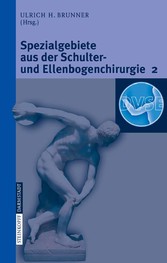Suchen und Finden
Service
Spezialgebiete aus der Schulter- und Ellenbogenchirurgie 2 - Update 2006
J. Dargel
Verlag Steinkopff, 2007
ISBN 9783798517332 , 247 Seiten
Format PDF, OL
Kopierschutz Wasserzeichen
11 Scapuladyskinesie (p. 174-175)
11.1 The Management of Muscle patterning Shoulder Instability
Jaggi A
Conventional non-operative management of shoulder instability has concentrated on strengthening exercises of the rotator cuff and scapula stabilizers, with varying degrees of success [1,3,9]. The fundamental principle in treating muscle patterning shoulder instability is relearning normal motor patterns with appropriate feedback. Re-establishing neuromuscular control must integrate peripheral somatosensory, visual and vestibular afferent input and improve motor control through spinal reflex, brain stem and cognitive programming [11,17].
Early Stage – Relocation of the GHJ with limb unloaded
Initial management includes explanation and reassurance to the patient. Compliance is paramount to any successful program. The patient is encouraged to refrain from voluntarily subluxing the shoulder in order not to reinforce abnormal patterning. Inhibition of overactive muscles can be taught via the use of biofeedback techniques. Normal patterns of movement can be facilitated via tactile feedback from the therapist [24], visual feedback via mirrors, surface EMG or videos.
Motor learning can be enhanced with the methods described and such biofeedback techniques have been shown to be more effective in regaining normal stability and control than strengthening exercises alone [2,15,19,21]. Biofeedback training appears to use the feed forward learning process [8] at a cortical level this may help to achieve efficient motor patterns based on appropriate afferent feedback.
Although there is abnormal increased tone in the upper limb there is often associated generalised low tone in the trunk. Enhancing postural stability and balance with the use of gym balls and wobble boards may help to activate deeper stabilisers and decrease fixation of the superficial torque muscles e.g. Latissimus Dorsi influencing the shoulder girdle [10]. Postural exercises will also enhance motor function at the brain stem level [11]. Tape can be very useful in the early stage to help provide feedback for posture and position sense of the shoulder girdle. The use of tape and various shoulder supports appear to help provide stability, aid in joint position sense and are useful adjuncts in training proprioception [5,6,13,20,25].
Intermediate Phase – Stability through range with limb loaded
Once the patient is able to inhibit inappropriate muscle activity then control with gentle resistance or limb loading can be applied. The patient can start rotator cuff strengthening exercises whilst monitoring for abnormal muscle activity. Weight bearing exercises enhance joint stability, stimulate muscular coactivation and facilitate proprioception [7,14,16,18,27,28]. Initial weight bearing exercises can be done with the upper limb stabilising on a fixed base of support, to then stabilising on a ball or wobble board, enhancing neuromuscular control at a reflex level. Exercises must be continually checked for abnormal movement faults and over activity in inappropriate muscle groups.
Advanced Phase – Functional Patterns/ Endurance &, Speed
End stage rehabilitation must be about retraining patterns of movement biased towards functional tasks. Functional exercises such as throwing, require coordination among multiple muscle groups and are recommended for retraining normal patterns of muscle activity [7].The position of instability should be challenged functionally to provoke reflexive muscular activity to prevent recurrence of instability [12].



